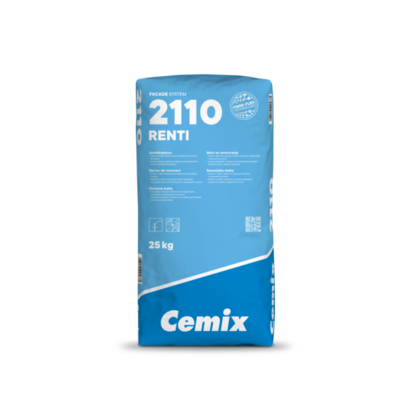|
2110
REPAIR PLASTER
Revitalize & protect with fibre-reinforced repair plaster
Bridge cracks, restore surfaces. Perfect for renovating modern and historic buildings
- Fibre-reinforced: crack-bridging. Ideal for equalising non-uniform, cracked surfaces.
- Excellent adhesion: suitable for renovation on coloured plaster and facade paint.
- Excellent water vapour permeability: suitable for the renovation of historic buildings.
- Excellent flexibility: Suitable for areas exposed to thermal expansion.
Area of application
- Outdoors: wall
- Indoor: wall
Processing method
- For hand and machine processing
- Repair material for masonry in new and old residential buildings, public buildings, industrial objects. Applicable as an adhesion bridge on smooth concrete surfaces with waterproofing, on surfaces with low absorption or on extruded polystyrene panels incorporated in the structure to avoid thermal bridges. It can be used as a fast drying primer layer on cement-bonded wood wool (e.g. Heraklith) boards. It is also suitable for resurfacing old acrylic resin or mineral coloured plasters.
Processing details
Learn more about technical details for processing this product.
Substrate requirement
The substrate must comply with the relevant standards, be sound, stable, free from loose particles, dust, dirt, oil, mould release agent residues and efflorescence.
Substrate temperatures between +5°C and +25°C are recommended.
Substrate preparation
The substrate must be of suitable strength and free from dust and dirt.
Before starting work, cover the surfaces to be protected.
Painted wall surfaces (surfaces painted with façade paint) must be cleaned with a high-pressure cleaner before application.
Preparation of the mixture
Pour 25 KG of CEMIX 2110 REPAIR PLASTER into 7 L of clean water (approx. 0.28 l/kg). Mix for 5 minutes with a slow-speed paddle mixer to a homogeneous mixture without lumps. Leave to rest for 5 minutes. Then mix again briefly. Use appropriate machinery for machine processing.
Water demand

| Quantity | Liters (recommended) |
|---|---|
| 25 kg | 7,0 |
Mixing



Processing instructions
Apply with a trowel or notched trowel. The mixing and application can also be done with a plastering machine (e.g. PFT G4). When using a machine, the application is done with the capabilities of the plastering machine, using a notched trowel or notched trowel. When embedding the glass fabric, apply a layer of 3-5 mm thickness, smooth it with a masonry smoother and then embed the glass fabric. As a reparation plaster, apply to old tinting plaster or painted surfaces at a maximum thickness of 10 mm. When applied as a thin coating, after cleaning the concrete surfaces, apply 3-5 mm thick in layers and smooth it.
Processing tools: notched trowel, stainless steel trowel, masonry spoon.
Application thickness

| Maximum layer thickness | 10 mm |
|---|
Consumption

Working time (potlife)

120 min
Treatment after application
The reparation plaster must not be exposed to frost during the setting period!
Tool and cleaning instructions
Wash off tools with water immediately after finishing work. Clean dried residues mechanically.
Technical parameters
| Main binder | Grey cement |
| Flammability class | A1 |
| Max. grain size | 1,2mm |
| Compressive strength 28 days in N/mm² | 5 N/mm² |
| Water absorption | W2 |
| Density in Kg/m³ | 1400 |
Files
|
|


